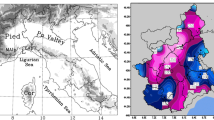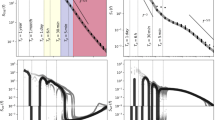Summary
The growth of error energy from initially uncertain states is a characteristic of global forecast models that is absent or markedly diminished in limited area forecasts. The enhanced regional predictability is presently studied with a limited area boundary layer model applied to a European region centered on the Alps. The results are remarkably insensitive to initial data, and a qualitative explanation of this is sought in terms of Thompson's (1957) and Lorenz's (1969) predictability analysis. It appears that the high predictability of regional models is an artifact of the overwhelming role that the prespecification of external boundaries plays in this problem. In cases that Dirichlet boundary conditions are imposed at the perimeter of the limited forecast region, the larger scale flow components, including most of the advecting flow are determined completely independently of internal dynamics and vorticity fluctuations, a condition that does not promote uncertainty growth.
The simplest relaxation of this constraint is accomplished by imposing Neumann boundary conditions with zero gradient of forecast variables at the outer boundary. In this case the boundary values depend completely upon the interior forecast, and there is no theoretical reason to expect that error growth should be limited. Nevertheless, present results show that the only significant forecast errors associated with initial uncertainties in these cases are trapped near external boundaries. An explanation of this phenomenon and its generality is discussed. Our forecast results and analysis of error spread from boundaries suggest that topography may enhance local predictability.
Although the predictability of a regional boundary layer model is high with respect to initial errors of even rather large magnitude, the same is not true with respect to large uncertainties in the representation of topography and surface, radiative and dissipative effects. Substantial variations of the parameterization of these processes through changes of the model equations produce boundary layer solution divergence with doubling time scales as short as one day. The uncertainty growth associated with smaller (and more realistic) perturbations of these processes remains to be studied.
Zusammenfassung
Das Anwachsen der Fehler auf Grund anfänglich unsicherer Zustände ist ein Charakteristikum globaler Vorhersagemodelle. Diese Beschränkung ist nicht vorhanden oder stark vermindert in Vorhersagen für begrenzte Gebiete. Die verbesserte regionale Vorhersagbarkeit wird gegenwärtig an einem Grenzschichtmodell untersucht, welches auf einen Teil Europas mit den Alpen im Zentrum angewandt wird. Die Ergebnisse sind auffallend im empfindlich gegenüber den Anfangsdaten. Eine qualitative Erklärung dafür kann anhand der Vorhersagbarkeitsanalyse von Thompson (1957) und Lorenz (1969) durchgeführt werden. Die hohe Vorhersagbarkeit regionaler Modelle erscheint als Ergebnis der überwältigenden Rolle, die die Vorgabe der äußeren Ränder in diesem Problem spielt. In Fällen, wo Dirichlet-Randbedingungen an der Peripherie des begrenzten Vorhersagegebietes aufgezwungen werden, erfolgt die Bestimmung der großräumigen Strömungskomponenten inklusive des größten Teils der advektierenden Strömung, unabhängig von der internen Dynamik und den Wirbelfluktuationen. Diese Bedingung fördert das Anwachsen von Unsicherheiten nicht.
Die einfachste Lockerung dieser Beschränkung wird durch Einführung von Neumann-Randbedingungen mit der Vorhersagevariablen ohne Gradienten an den äußeren Rändern erreicht. In diesem Fall hängen die Randwerte vollständig von der Vorhersage im Inneren ab und es besteht kein theoretischer Grund, eine Beschränkung des Fehlerwachstums zu erwarten. Dennoch zeigen die gegenwärtigen Ergebnisse, daß die einzigen wesentlichen Vorhersagefehler in Zusammenhang mit Anfangsunsicherheiten in diesen Fällen auf den Randbereich beschränkt sind. Eine Erklärung dieses Phänomens und seine Allgemeingültigkeit wird diskutiert. Unsere Vorhersageergebnisse und die Analyse der Fehlerausbreitung von den Rändern aus legt nahe, daß die topographie die lokale Vorhersagbarkeit verbessern kann.
Obwohl die Vorhersagbarkeit eines regionalen Grenzschichtmodells in bezug auf die verhältnismäßig großen Anfangsfehler hoch ist, ist dies nicht so in bezug auf die großen Unsicherheiten in der Wiedergabe der Topographie und der Oberfläche sowie Strahlungs- und dissipativer Effekte. Wesentliche Variationen der Parametrisierung dieser Prozesse durch Änderungen der Modellgleichungen erzeugen Divergenzen in den Grenzschichtlösungen, die sich schon in einem Tag verdoppeln. Das Wachstum der Unsicherheit verbunden mit kleineren (und realistischeren) Störungen dieser Prozesse bleibt noch zu untersuchen.
Similar content being viewed by others
References
Anthes RA (1985) The general question of predictability. AMS intensive course on mesoscale meteorological forecasting, 9–20 July, 1984. Mesoscale meteorology and forecasting, Peter S Ray (ed)
Anthes RA, Kuo YH (1985) Error growth rates in limited-area models; summary of preliminary results. GARP special report 43. Report of the seminar on progress in numerical modelling and the understanding of predictability as a result of the global weather experiment, WMO-ICSU, pp 111, 183–196
Anthes RA, Kuo YH, Baumhefner DP, Errico RM, Bettge TW (1985) Predictability of mesoscale motions. Advances in Geophysics, Issues in Atmospheric and Oceanic Modelling, in press
Astling EG, Paegle J, Miller E, O'Brien CJ (1985) Boundary layer control of nocturnal convection associated with a synoptic scale system. Mon Wea Rev 113: 540–552
Batchelor GK (1967) An introduction to geophysical fluid dynamics. Cambridge University Press, p 614
Dell'Osso, Tibaldi S (1985) Numerical experiments on ALPEX cases of lee cyclogenesis. Presented at the WMO conference on the results of the Alpine experiment, Venice, Italy, 28 October to 1 November, 1985
Errico R, Baumhefner DP (1985) Predictability experiments using a high-resolution limited-area model. NCAR ms no 0501/85-5. Submitted to Mon Wea Rev, p 33
Hortal M, Jansa A, Gimeno C (1985) Behavior of Spanish limited area model (LAM) in two cases of Mediterranean cyclogenesis. Presented at the WMO conference on the result of the Alpine experiment, Venice, Italy, 28 October to 1 November, 1985
Lorenz EN (1969) The predictability of a flow which possesses many scales of motion. Tellus 21: 289–307
Lorenz EN (1982) Barotropic instability of Rossby wave motion. J Atm Sci 29: 258–264
McGinley JA, Goerss JS (1985) Effects of blocking initialization and terrain representation on numerical simulation of Alpine lee cyclogenesis. Presented at the WMO conference on the results of the Alpine experiment, Venice, Italy, 28 October to 1 November, 1985
Mesinger F, Pierrehumbert RT (1985) Alpine lee cyclogenesis-numerical simulation and theory. Presented at the WMO conference on the results of the Alpine experiment, Venice, Italy, 28 October to 1 November, 1985
Paegle J, McLawhorn DW (1983) Numerical modelling of diurnal convergence oscillations above sloping terrain. Mon Wea Rev 111: 67–85
Paegle J, Paegle JN, McCorcle M, O'Brien CJ, Miller E (1984) Diagnoses and numerical simulation of a low-level jet during ALPEX. Beitr Phys Atm 57: 419–430
Paegle J, Vukicevic T (1986) The sensitivity of topographically modified low level flow predictions to input data. Submitted to Mon Wea Rev
Paegle JN, Robl E (1977) The time behaviour of the probability density function of some simplified atmospheric flows. J Atm Sci 34: 970–990
Pham HL (1985) The role of Alpine mountains representation in lee cyclogenesis simulation. Presented at the WMO conference on the results of the Alpine experiment, Venice, Italy, 28 October to 1 November, 1985
Smith R (1982) Aerial observations of the Yugoslavian Bora, ALPEX preliminary scientific results, ICSU, WMO, Geneva, GARP no 7
Tafferner A (1985) Numerical simulation of lee cyclogenesis during ALPEX with an isentropic coordinate model. Presented at the WMO scientific conference on the results of the Alpine experiment, Venice, Italy, 28 October to 1 November, 1985
Thompson PD (1957) Uncertainty of initial state as a factor in the predictability of large scale atmospheric flow patterns. Tellus 9: 275–295
WMO (1982) ALPEX experimental design, ICSU, WMO, GARP, Geneva, Switzerland
Author information
Authors and Affiliations
Additional information
With 14 Figures
Rights and permissions
About this article
Cite this article
Paegle, J., Vukicevic, T. On the predictability of low-level flow during ALPEX. Meteorl. Atmos. Phys. 36, 45–60 (1987). https://doi.org/10.1007/BF01045139
Received:
Revised:
Issue Date:
DOI: https://doi.org/10.1007/BF01045139




